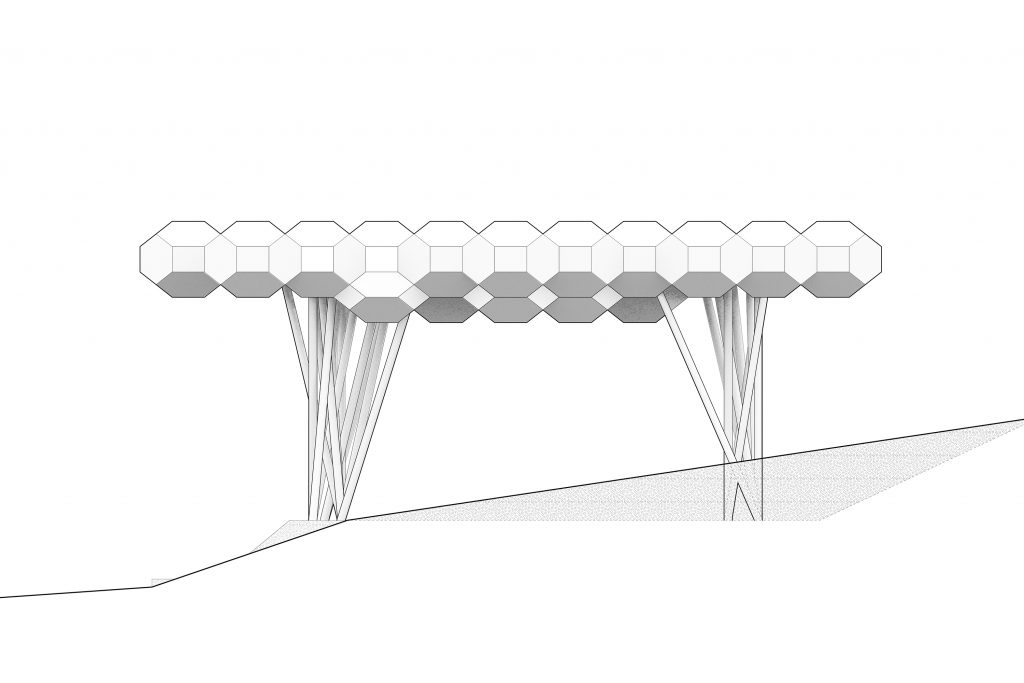ILIAD Lab Research Team: A. Brakke, S. Ferroni, F. Flores
Basic Data
- Date of Construction: 2011
- Date of last maintenance: 2014
- Location: Altos de Cazuca, Bogota
- Actors involved: Pies Descalzos Foundation, Shakira, Giancarlo Mazzanti
- Architect: El Equipo Mazzanti
- Plot ownership: Public land ownership
- Site visit objective: Define project’s impact on the local community
- Project objective: Provide the local community with sheltered soccer and basketball court
Location
Located on the northwest facing side of a slope the principal route of access to the project is on a major road for the neighborhood it sits in. Immediately uphill from the Mazzanti intervention sits a park in front of the Collegio Gabriel Garcia Marquez.
Calle 48, the road, connects the Transmillenio to the highest part of the neighborhood In close proximity sits a Police station, a school, and a church. Buses and trucks are frequent on Calle 48 and define the streetscape. From Uphill there is pedestrian access to the soccer court and the park.
Infrastructure
The neighborhood has quality access to electricity provided by the electrical provider. The park has free access to Wi-Fi located in front of the Collegio. There is free access to public drinkable water all day in the houses around the park. While the nearby Collegio was present prior to the intervention following the construction of the canopy a new Collegio was created uphill still donated by Shakira’s foundation.
Community
The community of the neighborhood is quite diverse and contains foreigners. According to a local who has lived in front of the park for 30 years the community is quite strong. According to her, the area of the park is quite safe even to walk at night while uphill it becomes more dangerous. The community has a Salon Communal that is located uphill from the project.
Organizers
Pies Descalzos Foundation is a Bogota-based foundation that builds public spaces and civic buildings in low-income communities. They specialize in increasing the level of education throughout Colombia. They raise funds from both privates and public actors. In the case of the El Bosque de la Esperanza most funds were devoted by Shakira. The architect of the project, Giancarlo Mazzanti is well known for a community-based social project which aims to increase the quality of life in Colombia’s slums and rural areas.
Plot ownership
The plot of land on which the intervention sits is publicly owned by the government which funded the pre-existing soccer court.
Objective of project
The aim of the addition of the canopy was to provide the community with a sheltered space for both sports and didactic activities, trying to develop community life in a neighborhood known for its lack of public space and of social infrastructure. The modularity of the canopy allows it to adapt to different site conditions. ( adapted from the architect’s website) The structure has become somewhat of a landmark not because of the architectural intervention per se but because it was donated by Shakira. this has changed his identification from Parque de la Esperanza to Parque de Shakira.
Project comments
The major danger for the users of the structure is the lack of a fence around the court which forces the children, most common users, to follow the ball into the street putting themselves in the danger with the traffic. In order to hold up the modular roof of the structure, tilted columns, resembling a cluster of bamboo in a forest, are positioned along the long side of the sports court forcing a complex geometry on the perimeter which complicated the addition of fencing towards the road. A frame construction in metal along the edges of the module creates the hexadecimal module which then is repeated in order to achieve the volume of the canopy. At first glance, the modules themselves represent the primary structure of the project while form above beams is apparent connecting the tilted columns and holding up the roof. Waterproofing is achieved by covering the top part of the modules with transparent corrugated plastic roofing sheets. The outer faces of the modules are clad in a green net, which was then broken into by a community of pigeons who now live in the structure. Maintenance of the canopy is required every few years to clean it from the bird’s biological waste and feathers. The bird’s waste also represents a health hazard for the health of the users.
The presence of the pigeons and their waste creates a sense of fear, while unnecessary, in the mind of the interviewed local who is afraid the structure will down from the weight of the biologic waste. Ultimately, the presence of the canopy, the latest addition to this public space only provides for a sheltered space for kids to play and for the community to meet while not influencing its community in any way.
According to the interviewed local, the canopy per se has not improved the neighborhood if not in instilling a sense of pride within the community to have a Shakira financed project.








